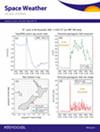2015 年卡尔布科火山爆发产生的电离层扰动:GITM-R 模拟与全球导航卫星系统观测结果的比较
IF 3.7
2区 地球科学
引用次数: 0
摘要
火山爆发为大气层提供了广泛的频谱强迫,而了解与解释电离层-热大气层(IT)中各种波形特征相关的主要机制仍然是社会各界面临的一个重要的未决问题。在本研究中,分析了全球导航卫星系统(GNSS)总电子含量(TEC)数据,并将其与全球电离层-热大气层模型(GITM-R)针对 4 月 22 日发生的 2015 年卡尔布科喷发第一阶段所做的模拟进行了比较。简化的源表示和频谱声重力波(AGW)传播模型用于指定 GITM-R 下边界 100 公里高度处的扰动。对传播结构的两种假设,即直接球形(DS)和地面耦合(GC),与全球导航卫星系统数据进行了比较,这些建模规格与观测数据的某些波形特征的不同方面显示出良好的一致性。最值得注意的是,GITM-R 能够再现 AGW 的相对波幅与喷口径向距离的函数关系,显示近场(<500 公里)以声波为主,远场(>500 公里)以重力为主。GITM-R 模拟估计的视相位速度与观测结果一致,声波包和尾随重力模式与观测结果相差 10%。然后讨论了低层大气中的简化与模拟 IT 响应的相关性。本文章由计算机程序翻译,如有差异,请以英文原文为准。
Ionospheric Disturbances Generated by the 2015 Calbuco Eruption: Comparison of GITM-R Simulations and GNSS Observations
Volcanic eruptions provide broad spectral forcing to the atmosphere and understanding the primary mechanisms that are relevant to explain the variety in waveform characteristics in the Ionosphere-Thermosphere (IT) is still an important open question for the community. In this study, Global Navigation Satellite System (GNSS) Total Electron Content (TEC) data are analyzed and compared to simulations performed by the Global Ionosphere-Thermosphere Model with Local Mesh Refinement (GITM-R) for the first phase of the 2015 Calbuco eruption that occurred on 22 April. A simplified source representation and spectral acoustic-gravity wave (AGW) propagation model are used to specify the perturbation at the lower boundary of GITM-R at 100 km altitude. Two assumptions on the propagation structure, Direct Spherical (DS) and Ground Coupled (GC), are compared to the GNSS data and these modeling specifications show good agreement with different aspects of the observations for some waveform characteristics. Most notably, GITM-R is able to reproduce the relative wave amplitude of AGWs as a function of radial distance from the vent, showing acoustic dominant forcing in the near field (<500 km) and gravity dominant forcing in the far-field (>500 km). The estimated apparent phase speeds from GITM-R simulations are consistent with observations with ∼10% difference from observation for both acoustic wave packets and a trailing gravity mode. The relevance of the simplifications made in the lower atmosphere to the simulated IT response is then discussed.
求助全文
通过发布文献求助,成功后即可免费获取论文全文。
去求助

 求助内容:
求助内容: 应助结果提醒方式:
应助结果提醒方式:


